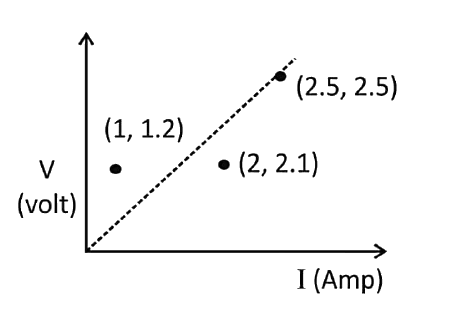Resistance of a wire is 8Ω. It is drawn in such away that it experiences a longitudinal strain of 400 %. The new resistance is
100Ω
200Ω
300Ω
400Ω
The correct Answer is:B
To find the new resistance of the wire after it has been drawn and experiences a longitudinal strain of 400%, we can follow these steps:
Step 1: Understand the given data
- Initial resistance R=8Ω
- Longitudinal strain ϵ=400%=4
Step 2: Calculate the new length of the wire
The longitudinal strain is defined as the change in length per unit original length. Thus, if the original length is L, the new length L′ can be calculated as:
L′=L+ϵ⋅L=L+4L=5L
Step 3: Use the volume conservation principle
Since the volume of the wire remains constant during the drawing process, we can express this as:
A⋅L=A′⋅L′
where A is the original cross-sectional area and A′ is the new cross-sectional area. Rearranging gives:
A′=A⋅LL′
Step 4: Substitute the new length into the area equation
Substituting L′=5L into the equation for A′:
A′=A⋅L5L=A5
Step 5: Calculate the new resistance
The resistance of a wire is given by the formula:
R=ρLA
For the new resistance R′:
R′=ρL′A′=ρ5LA5=ρ5L⋅5A=25⋅ρLA
Thus, we can express the new resistance in terms of the original resistance:
R′=25R
Step 6: Substitute the original resistance
Given R=8Ω:
R′=25⋅8=200Ω
Final Answer
The new resistance R′ is 200Ω.
---
- Initial resistance R=8Ω
- Longitudinal strain ϵ=400%=4
The longitudinal strain is defined as the change in length per unit original length. Thus, if the original length is L, the new length L′ can be calculated as:
L′=L+ϵ⋅L=L+4L=5L
Since the volume of the wire remains constant during the drawing process, we can express this as:
A⋅L=A′⋅L′
where A is the original cross-sectional area and A′ is the new cross-sectional area. Rearranging gives:
A′=A⋅LL′
Substituting L′=5L into the equation for A′:
A′=A⋅L5L=A5
The resistance of a wire is given by the formula:
R=ρLA
For the new resistance R′:
R′=ρL′A′=ρ5LA5=ρ5L⋅5A=25⋅ρLA
Thus, we can express the new resistance in terms of the original resistance:
R′=25R
Given R=8Ω:
R′=25⋅8=200Ω
The new resistance R′ is 200Ω.
Topper's Solved these Questions
- APPENDICES ( REVISION EXERCISE )Book:AAKASH SERIESChapter:APPENDICES ( REVISION EXERCISE )Exercise:REVISION EXERCISE (MOVING CHANGES & MEGNETISM)
Explore 95 Videos
- APPENDICES ( REVISION EXERCISE )Book:AAKASH SERIESChapter:APPENDICES ( REVISION EXERCISE )Exercise:REVISION EXERCISE (MAGNETISM AND MATTER )
Explore 52 Videos
- APPENDICES ( REVISION EXERCISE )Book:AAKASH SERIESChapter:APPENDICES ( REVISION EXERCISE )Exercise:REVISION EXERCISE (ELECTRIC POTENTIAL & CAPACITANCE )
Explore 143 Videos
- ALTERNATING CURRENTBook:AAKASH SERIESChapter:ALTERNATING CURRENTExercise:EXERCISE - III
Explore 24 Videos
- APPENDICES (REVISION EXERCISE)Book:AAKASH SERIESChapter:APPENDICES (REVISION EXERCISE)Exercise:LAW OF MOTION
Explore 128 Videos
Similar Questions
Resistance of tungsten wire at 150∘C is 133Ω. Its resistance temperature coefficient is 0.0045/∘C. The resistance of this wire at 500∘C will be
View SolutionThe resistance of a wire is 10Ω. Its length is increased by 10% by stretching. The new resistance will now be
View SolutionThe resistance of a wire R Ω . The wire is stretched to double its length keeping volume constant. Now, the resistance of the wire will become
View SolutionThe resistance of a wire is R ohm. If it is melted and stretched to n times its original length, its new resistance will be
View SolutionA wire of lenth L is drawn such that its diameter is reduced to half of its original diamter. If the initial resistance of the wire were 10Ω, its new resistance would be
View SolutionA metal wire has a resistance of 35Ω. If its length is increased to double by drawing it, then its new resistance will be
View SolutionWhen the resistance of copper wire is 0.1Ω and the radius is 1mm, then the length of the wire is (specific resistance of copper is 3.14×10−8ohm×m)
View SolutionA wire of length 100 cm is connected to a cell of emf 2 V and negligible internal resistance. The resistance of the wire is 3Ω. The additional resistance required to produce a potential drop of 1 milli volt per cm is
View SolutionThe temperature coefficient of resistance of a wire is 0.00145∘C−1. At 100∘C its resistance is 2Ω. At what temperature the resistance of the wire be 3Ω?
View SolutionIn the measurement of resistance of a wire using Ohm's the plot between V and I is drawn as shown, then resistance of given wire will be

View Solution

